Discover 11 hidden attractions, cool sights, and unusual things to do in Logan (United States). Don't miss out on these must-see attractions: Logan Utah Temple, Erick Lehi and Ingrid Larsen Olson House, and Logan Tabernacle. Also, be sure to include Maverik Stadium in your itinerary.
Below, you can find the list of the most amazing places you should visit in Logan (Utah).
Table of Contents
Logan Utah Temple
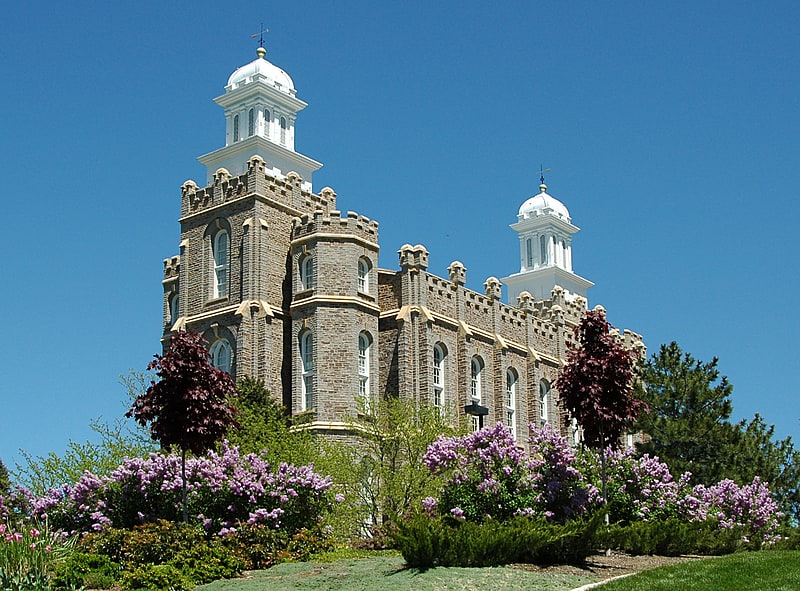
Temple in Logan, Utah. The Logan Utah Temple was completed in 1884, and is the fourth temple built by The Church of Jesus Christ of Latter-day Saints. Located in the city of Logan, Utah, it was the second temple built in the Rocky Mountains, after the St. George Temple, which remains the only Latter-day Saint temple that has been in operation longer than the Logan Temple.
The temple in Logan was announced on October 6, 1876, with its groundbreaking taking place on May 18, 1877. The groundbreaking was shortly after dedication of the St. George Temple on April 6, 1877. The site of the Logan Temple had been held in reserve for many years. It was used as a park and public grounds before being dedicated as the site for the temple. The Salt Lake Temple had been announced in 1847, but construction was still underway and would not be completed until 1893, so the Logan and St. George temples were built to satisfy the church's need for temples.
More than 25,000 people worked on the Logan Temple. Timber for the building was hauled from the Temple Fork area of Logan Canyon. Lime and quartzite was quarried out of nearby Green Canyon. Most materials were extracted during winter when farm duties were low and because transporting material was easier on sled than wagon. A combination of hired hands and volunteers were used with wards providing quotas of volunteers. As completion of the temple neared, women in the area were asked to make carpets for the temple as funds did not allow them to purchase store made carpet for the entire building. The women spent two months working to hand make 2,144 square yards of carpet.
The Logan Temple was the second temple to be completed in the Utah area and is the church's sixth largest. It was built on a 9-acre plot selected by church president Brigham Young and has 4 ordinance rooms and 11 sealing rooms, with a total floor area of 119,619 square feet.The design by the church's head architect, Truman O. Angell, had two towers and was based on the same pattern as the Salt Lake Temple, with a large assembly hall and other similar rooms. On May 17, 1884, the Logan Temple was dedicated by church president John Taylor. The design incorporates an unusual amount of Gothic detailing compared with other temples, which are more Renaissance or Byzantine-inspired.
In 1917, a fire started in a closet under the grand staircase in the central north part of the main building. it completely destroyed this oval staircase which connected the first through the third floors. It caused about $40,000 in damage and took about three months to repair. In 1949, the temple was remodeled and received updated lighting, heating, air conditioning, elevators, and other modern conveniences. In 1977, more remodeling was undertaken and the interior was completely gutted and redone. After remodeling, the temple was rededicated on March 13, 1979, by church president Spencer W. Kimball.
The Logan Temple was placed on the National Register of Historic Places on November 20, 1975.[1]
Address: 175 N 300 E, 84321-4720 Logan
Erick Lehi and Ingrid Larsen Olson House
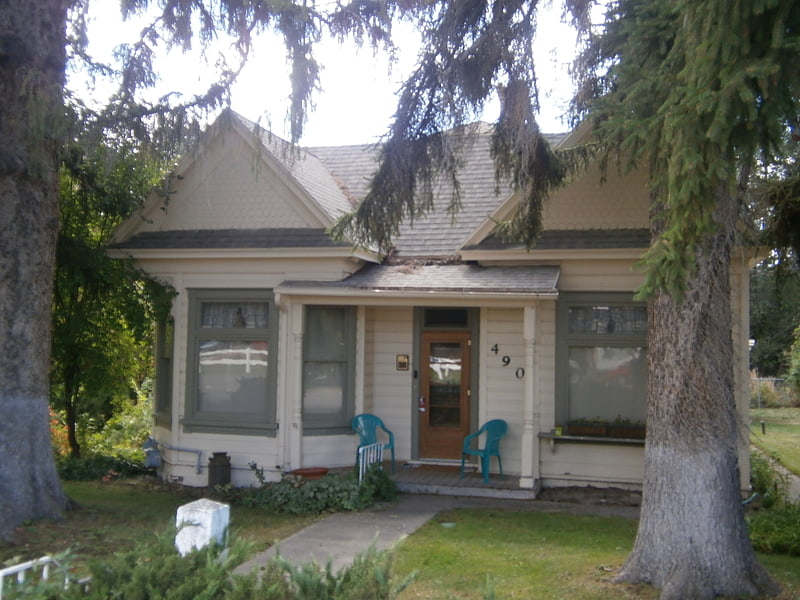
The Erick Lehi and Ingrid Larsen Olson House is a historic house in River Heights, Utah. It was built in 1891 for Erick Lehi Olson, an immigrant from Sweden who converted to The Church of Jesus Christ of Latter-day Saints at age 16 and arrived in America in 1882.
His wife, née Ingrid Larsen, was also an immigrant from Sweden, where she converted to the LDS Church; she arrived in America in 1883. The Olsons lived in Logan before they moved to River Heights, where Olson served as the bishop and as the president of the Third Quorum of Elders of the Cache Stake. Their house was designed in the Queen Anne architectural style. It has been listed on the National Register of Historic Places since March 8, 1997.[2]
Address: 400 South 600 East, Logan
Logan Tabernacle
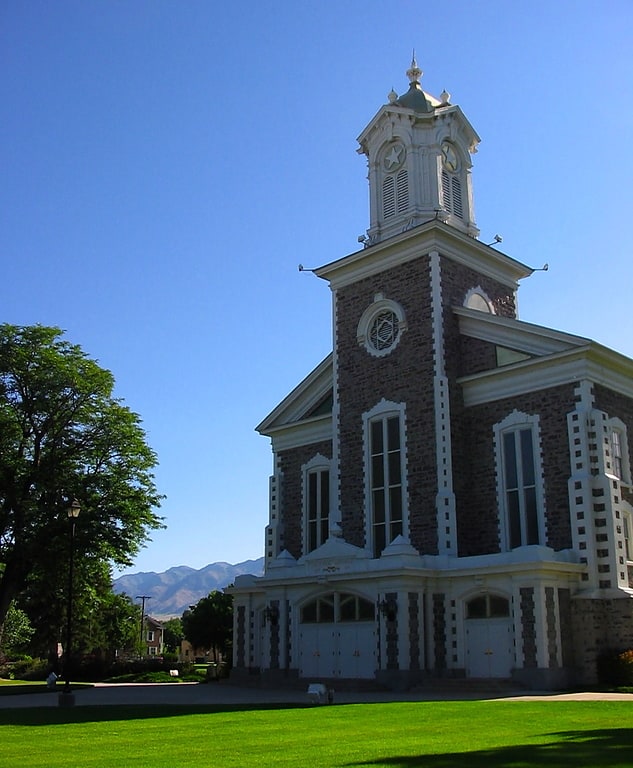
The Logan Tabernacle is a tabernacle of The Church of Jesus Christ of Latter-day Saints and is located in Logan, Cache County, Utah. It is used regularly for church meetings, most often semi-annual Stake Conferences as well as seminary graduations, musical concerts of various kinds and lectures. The tabernacle welcomes visitors and is open for tours each summer from June to September. It is the site of many local celebrations, including the city's annual Summerfest Arts Faire held each June on the tabernacle grounds.[3]
Address: 100 N Main St, 84321-4526 Logan
Maverik Stadium
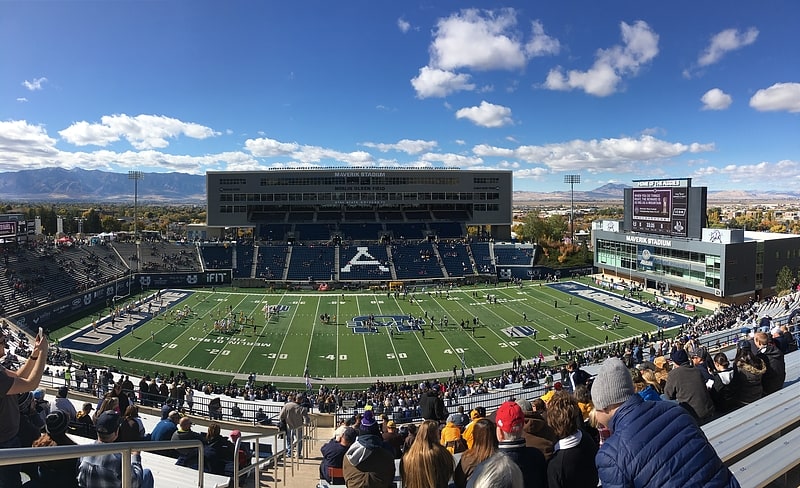
Stadium in Logan, Utah. Maverik Stadium, also known as Merlin Olsen Field at Maverik Stadium, is an outdoor college football stadium in the western United States, on the campus of Utah State University in Logan, Utah. The home field of the Utah State Aggies of the Mountain West Conference, it opened 54 years ago in 1968 as "Romney Stadium" and currently has a seating capacity of 25,100. Its field has a traditional north-south alignment, and sits at an elevation of 4,710 feet above sea level. The playing surface was natural grass through 2003, and is currently AstroTurf GameDay Grass.
Previously named for Dick Romney, USU's all-time most successful football coach and former athletics director, Romney Stadium was officially dedicated on September 27, 1969. The first game in the stadium came a season earlier in 1968, when USU defeated New Mexico State 28–12 on September 14.[4]
David Eccles House
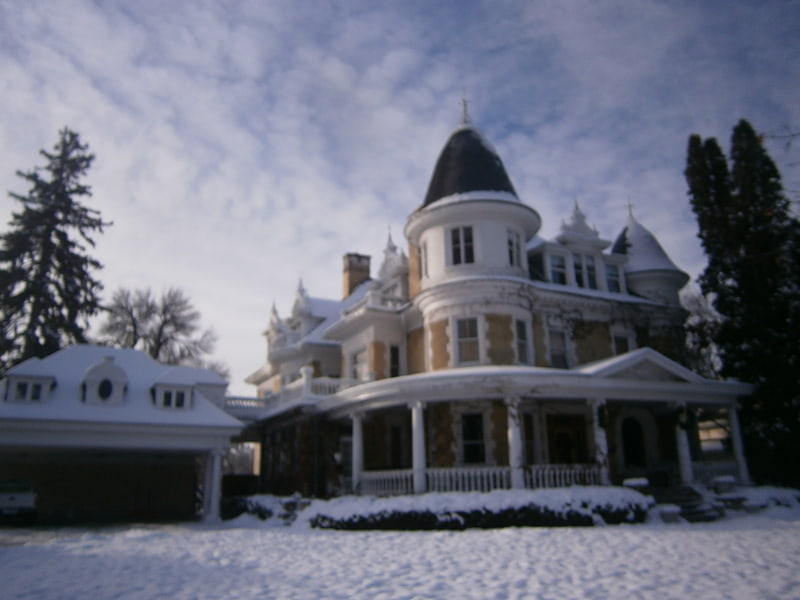
The David Eccles House, at 250 W. Center St. in Logan, Utah, was built in 1907. It was listed on the National Register of Historic Places in 1976.
It was designed by Logan architects Joseph Monson and Karl C. Schaub. Overall it is Eclectic or Late Victorian in style, with Queen Anne influence, with numerous Classical Revival style details, and with two turrets which have been termed Chateauesque.
Through 1976 it was regarded as the largest home in Cache Valley. It has three stories, 24 rooms, and 11,000 square feet (1,000 m2).
In 1943 it became a dormitory for the Utah State Agricultural College and was cut up into bedrooms and bathrooms. Later it was a fraternity house. It was sold in 1970 to private owners who renovated it, and by 1976 much of its original character had been restored.[5]
Whittier Community Center
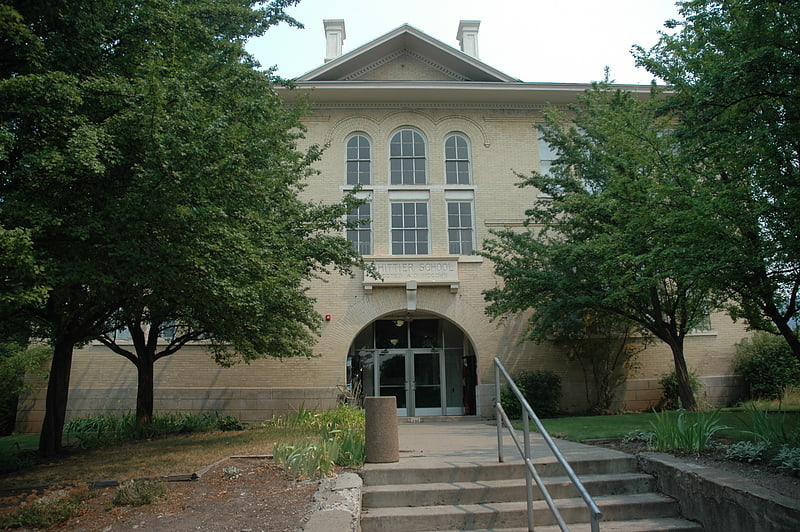
The Whittier School in Logan, Utah, at 280 North 400 East, was built in 1908. It was listed on the National Register of Historic Places in 2000.
It was designed by Logan architect Joseph Monson. It includes elements of Romanesque and Prairie School architecture.
It was the site of the Emma Eccles Jones' development of the first kindergarten program in Utah; she taught for three years without salary and raised funds for the program, which became the model for future kindergarten programs that went statewide in 1947.
It was a district school for 19 years, then served as a laboratory school for the Utah State Agricultural College, from 1927 on for 30 years. Later it was a community arts center.[6]
Ellen Eccles Theatre

Theatre in Logan, Utah. The Ellen Eccles Theatre was built in 1923 on Logan, Utah's Main Street. Then known as the Capitol Theatre, it was a home originally to vaudeville and opera. As vaudeville died out, it became used primarily for community events and, increasingly, movies. By the 1980s, the Capitol had fallen into disrepair and become a run-down home for second-run movies.
In 1988, it seemed likely that the Capitol would be demolished and turned into a parking lot. Popular outcry, however, led to the city of Logan purchasing the theatre and a not-for-profit organization was formed to renovate and operate it, now known as the Cache Valley Center for the Arts. This restoration effort hit a setback in 1990 when fire destroyed much of the theater's annex. However, work continued, and the house, christened the Ellen Eccles Theatre after the family member of one of the principal philanthropists, opened to a gala performance on January 8, 1993.
The theatre, which seats approximately 1100, is used for concerts, community theatre, and ballet performances, and classic movies as well as being a popular stop for many national touring acts each year. It is the venue for performances of the Utah Festival Opera Company for 4 weeks in the summer, and dozens of performances during the rest of the year by the Cache Valley Civic Ballet, Music Theatre West, Valley Dance Ensemble, Cache Theatre Company, and several Utah State University performing groups.[7]
Address: 43 S Main St, 84321 Logan
Merrill–Cazier Library

University library in Logan, Utah. The Merrill–Cazier Library is an academic library serving the students of Utah State University and the community of Logan, Utah.[8]
Address: 3000 Old Main Hl, 84322 Logan
Performance Hall
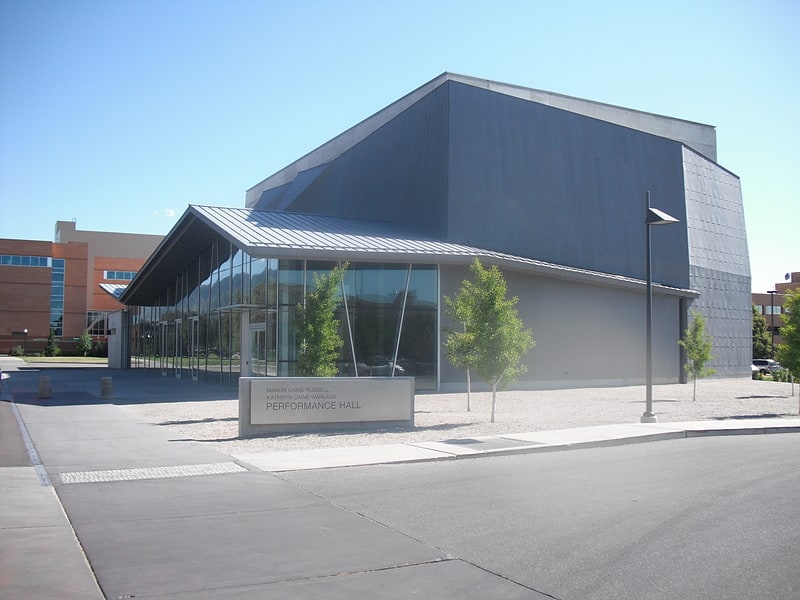
The Manon Caine Russell Kathryn Caine Wanlass Performance Hall is a modern recital hall on the campus of Utah State University.
The Performance Hall, by which name it is usually known, was a gift to USU from two alumni sisters in 2006. Since its opening, the Performance Hall has become widely known in the region for its architecture and acoustics. The building itself was designed by Boston firm Sasaki Associates with acoustics overseen by Artec Consultants. The building is said to have some of the best acoustics in the western United States. Great lengths were taken in construction to ensure sound quality, such as the suspension of all mechanical systems on pads or springs "to avoid the slightest vibration or extraneous sound." The building has won numerous regional awards for its design, including from the Utah Chapter of the American Institute of Architects, and Best Architecture Project and Best Mechanical/Electrical Project from Intermountain Contractor.
The Performance Hall is used principally for student recitals from the Caine College of the Arts at USU. It also houses the Fry Street Quartet, USU's string-quartet-in-residence, as well as a limited number of smaller touring productions. Together with the Chase Fine Arts Center next door, it constitutes a significant portion of the Fine Arts Complex on the Logan campus of Utah State University.[9]
Family Life Building
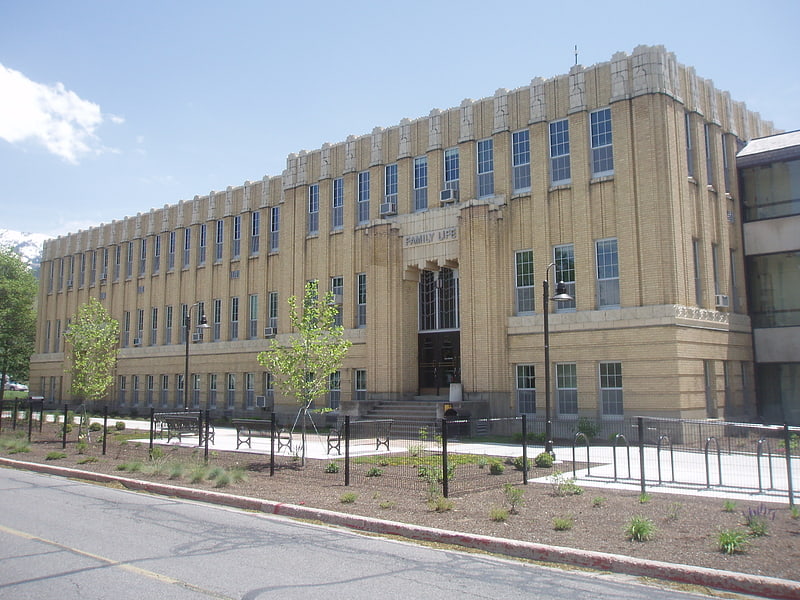
The Family Life Building on the Utah State University in Logan, Utah was built in 1935. It was built as a Public Works Administration project, providing jobs during the Great Depression, and "to house the schools's Home Economics Department and all student union activities." It was listed on the National Register of Historic Places as Home Economics/Commons Building in 1985.
It is a large two-story flat-roofed building, with narrow, recessed window panels and a crenelated parapet. Transoms include zig-zag tracery. It was designed by architects Hodgson & McClenahan; it was built by general contractor Soren Jacobsen of Logan.
It is Art Deco in style and was asserted to be "one of the best examples of the Art Deco architectural style in Utah."
It is known as the Family Life Building. It is located off U.S. Route 89 on the Utah State University campus.[10]
American West Heritage Center
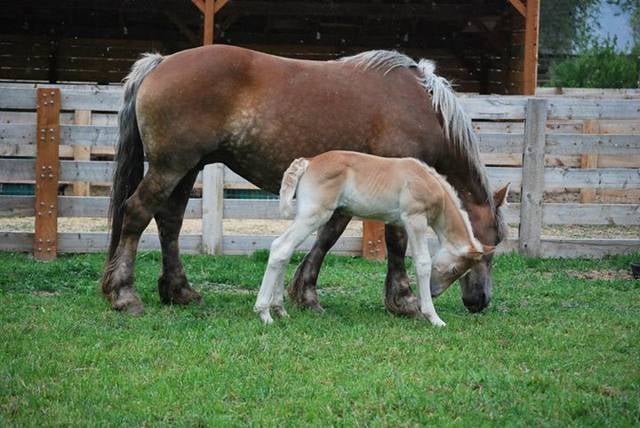
History museum, Museum
Address: 4025 S Highway 89, 84339-9582 Wellsville